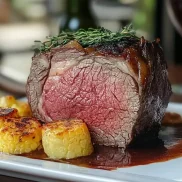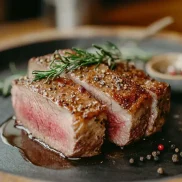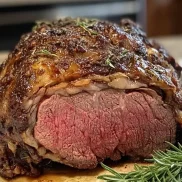Is there a difference between au jus and au jus gravy? This question often arises among food enthusiasts seeking to enhance their meals with the right accompaniment. Have you ever savored a dish and wondered what makes it so delectably rich and flavorful? For many meat-centric dishes, the secret lies in the sauce.
These terms often appear interchangeably, but they aren’t the same. In this article, we’ll unravel the nuances between au jus and au jus gravy, delving into their origins, meaning, and how each contributes to elevating a meal. Whether you’re a culinary enthusiast or simply curious, understanding these subtle distinctions can transform the way you approach cooking and dining. Explore our detailed guide on the perfect prime rib roast au jus recipe here.
Table of Contents
Understanding Au Jus: Origins and Meaning
Au jus, a French term meaning “with juice,” embodies the art of simplicity in cooking. It refers to the natural juices released by meat during cooking, enhanced with a few subtle ingredients. Unlike thickened gravies, au jus is celebrated for its light, broth-like consistency that perfectly complements roasted meats like beef, lamb, or chicken. This unassuming sauce has found its way from French kitchens to dining tables worldwide, often seen as the hallmark of an elevated meal.
What Does “Au Jus” Mean in French Cuisine?
In the culinary traditions of France, au jus is more than just a sauce; it’s an expression of respect for the natural flavors of food. The term “au jus” literally translates to “with juice,” emphasizing the importance of retaining and enhancing the meat’s own essence. This technique often involves deglazing the pan with wine or stock to create a rich, flavorful liquid. Herbs, garlic, and sometimes shallots are added to enhance but never overpower the taste of the meat itself. In French cuisine, au jus is served as a light accompaniment, allowing the quality of the roast to shine through.
Historical Context: How Au Jus Became Popular
The concept of au jus originated in the refined kitchens of French aristocracy, where chefs prioritized subtlety and balance over heavy sauces. During the 19th century, as French cuisine gained international acclaim, the technique spread across Europe and eventually to America. In the U.S., au jus gained significant popularity during the mid-20th century, particularly with the rise of French dips and prime rib dishes in restaurants. Its adaptability and ease of preparation made it a favorite among home cooks and professional chefs alike.
Traditional Preparation Methods for Au Jus
To prepare au jus traditionally, collect the juices that naturally pool in the roasting pan. Deglaze the drippings with a liquid, often beef or chicken stock, and occasionally a splash of red wine. Add aromatics like onions, garlic, and rosemary to deepen the flavor. Simmer the mixture gently to concentrate the flavors and then strain it for a smooth, clean finish. Unlike gravies, au jus remains delicate and light because it is never thickened with flour or cornstarch. This approach ensures the sauce enhances the meat rather than overshadowing it.
Defining Au Jus Gravy: A Modern Twist
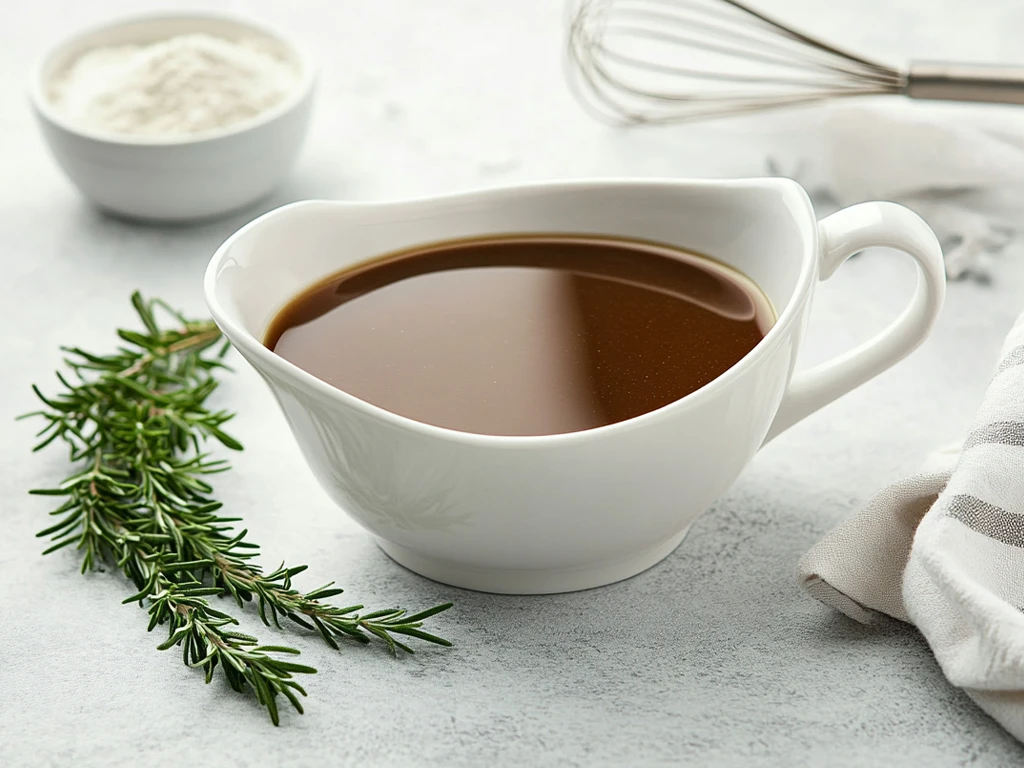
Key Ingredients in Au Jus Gravy Recipes
This gravy builds on the natural meat drippings from classic au jus and incorporates ingredients for a richer profile. Key components include:
- Meat Drippings: The flavorful foundation collected from roasting beef, pork, or poultry.
- Stock or Broth: Typically beef or chicken stock enhances umami and extends the sauce.
- Thickening Agents: Flour or cornstarch creates the desired consistency.
- Seasonings: Salt, pepper, garlic, onion powder, and Worcestershire or soy sauce for depth.
- Optional Add-Ins: Fresh herbs like thyme or rosemary and sometimes butter or cream enrich the flavor and texture.
These elements combine to craft a gravy hearty enough to pair with a range of side dishes or stand alone as a robust sauce.
How Au Jus Gravy Evolved from Classic Au Jus
The transformation of au jus into gravy reflects evolving culinary trends prioritizing versatility and indulgence. During the mid-20th century, as convenience became key, home cooks began adapting au jus to better complement hearty sides like mashed potatoes or stuffing. Thickening agents ensured the sauce could coat foods instead of soaking in.
Regional preferences further shaped this evolution. In areas where gravies are staples, such as the Southern U.S. or parts of the UK, au jus gravy delivered the rich texture and flavor that diners craved. Over time, it became a popular choice for holiday meals and everyday dinners alike.
Common Uses of Au Jus Gravy in Modern Cooking
Today, this gravy is a versatile and beloved addition to many dishes. Its thick, flavorful profile makes it ideal for:
- Roasts and Meats: Perfect for topping beef roasts, turkey, or pork chops.
- Side Dishes: Drizzle over mashed potatoes, stuffing, or roasted vegetables for a comforting touch.
- Sandwiches: Frequently featured in open-faced sandwiches or French dips.
- Comfort Foods: A classic topping for meatloaf, Salisbury steak, or fried chicken.
In everyday cooking, au jus gravy also works well in casseroles or as a base for pot pies. Its versatility has secured its place as a kitchen staple, offering satisfying depth to both traditional and modern dishes.
Is There a Difference Between Au Jus and Au Jus Gravy? Key Distinctions Explained
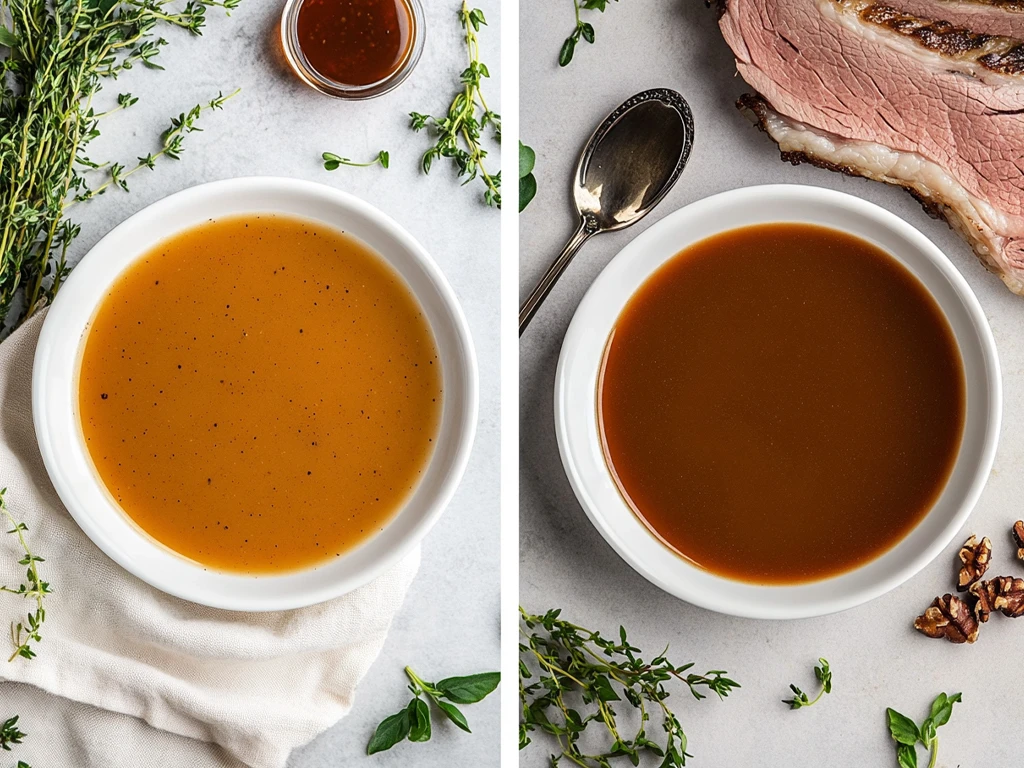
Though they share similar origins and a rich, savory profile, au jus and au jus gravy differ in significant ways. These distinctions lie in their consistency, ingredients, and preparation methods, each tailored to unique culinary applications. Understanding these differences not only enhances your appreciation of both but also helps you decide which one suits your dish best.
Consistency: Liquid vs. Thickened Sauces
The most noticeable difference between au jus and au jus gravy is their consistency. Au jus is light and liquid, closely resembling a flavorful broth. This thin texture allows it to seep into the meat, enhancing the dish without overpowering it. Au jus is perfect for dipping or lightly drizzling over meat to maintain moisture.
In contrast, au jus gravy is thicker and more substantial. Thickening agents like flour or cornstarch are used to create a velvety, clingy texture that stays on the surface of meats and side dishes. This richness makes au jus gravy an excellent topping for mashed potatoes, stuffing, or hearty roasts. While au jus is often sipped or soaked up with bread, au jus gravy feels more filling and indulgent.
Ingredients: Purity vs. Complexity
Another key difference lies in the ingredient list. Traditional au jus relies on minimal, pure ingredients: meat drippings, a splash of stock or wine, and simple seasonings like salt, pepper, and herbs. This minimalist approach highlights the natural flavor of the meat.
Au jus gravy, on the other hand, is more complex. It starts with the same meat drippings but incorporates additional elements like flour, butter, and a wider array of seasonings. Worcestershire sauce, soy sauce, or even cream may be added to deepen the flavor and enrich the texture. While au jus celebrates simplicity, au jus gravy embraces boldness and variety.
Cooking Techniques: Traditional vs. Modified
The preparation of au jus stays true to its roots in classic French cooking. After roasting meat, the pan drippings are deglazed with stock or wine, simmered with herbs, and strained to create a smooth, light sauce. The focus is on preserving and amplifying the meat’s natural juices.
Au jus gravy, however, requires additional steps. Once the au jus base is prepared, a thickening agent such as a flour-and-butter roux or a cornstarch slurry is whisked in to create the gravy’s signature texture. This modification aligns with the preferences of regions where rich, hearty gravies are favored. While au jus remains true to its minimalist French heritage, au jus gravy reflects a more modern and adaptive approach to comfort food.
By understanding these distinctions, you can appreciate the unique roles each sauce plays in enhancing a meal. Whether you prefer the clean, light flavor of au jus or the hearty indulgence of au jus gravy, each brings its own charm to the table.
Situational Uses for Au Jus and Au Jus Gravy
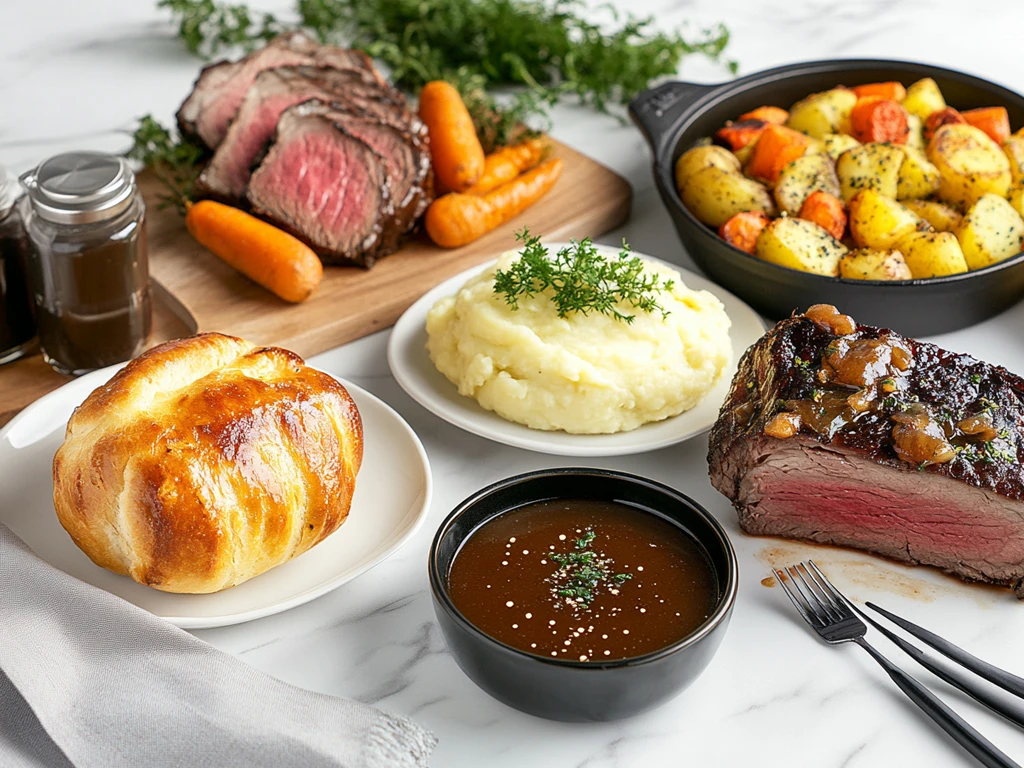
Both au jus and au jus gravy have their own unique roles in the culinary world. Each enhances dishes in specific ways, tailored to the meal’s texture, flavor profile, and presentation. Whether you’re hosting a fancy dinner or preparing comfort food, understanding when to use au jus or au jus gravy can make all the difference in your meal’s success.
Pairing Au Jus with Prime Rib and Steak
Au jus is a natural partner for premium cuts of meat like prime rib and steak. Its thin, flavorful consistency allows it to accentuate the meat’s juiciness without overwhelming its natural taste. For a perfectly cooked prime rib, au jus serves as a light yet luxurious addition that enhances the smoky, roasted flavors while keeping the meat moist.
Similarly, for steak lovers, au jus provides an elegant dipping sauce that elevates the dining experience. Ribeye, filet mignon, or New York strip steak pairs beautifully with au jus, particularly when infused with herbs like rosemary or thyme. The simplicity of au jus complements the richness of the meat, ensuring every bite is flavorful and tender. For added indulgence, try serving au jus in a small bowl alongside the steak, allowing diners to control how much they use.
Popular Dishes Enhanced by Au Jus Gravy
With its thicker texture and robust flavor, is ideal for heartier dishes and comfort foods. This versatile sauce pairs well with:
- Roasts: Whether it’s turkey, pork, or beef, au jus gravy adds a rich, velvety layer that enhances both flavor and texture. It’s particularly popular during holiday meals.
- Mashed Potatoes: Drizzling au jus gravy over creamy mashed potatoes creates a comforting side dish that’s hard to resist.
- Stuffing: A generous serving of au jus gravy brings out the savory herbs and spices in traditional stuffing recipes.
- Meatloaf: Elevate this classic comfort food by topping it with a hearty ladle of gravy.
- French Dips and Open-Faced Sandwiches: This thicker alternative to traditional au jus is perfect for smothering sandwiches and adding extra richness to each bite.
In everyday cooking, this gravy can also be used creatively in casseroles or as a base for pot pies. Its versatility makes it a kitchen staple, offering a satisfying depth of flavor to a variety of dishes.
By choosing the right sauce for the occasion, you can highlight the best features of your meal and delight your guests with a perfectly paired accompaniment.
The Nutritional Perspective: Which Is Healthier?
When deciding between au jus and au jus gravy, understanding their nutritional differences can help you make an informed choice for your meal. While both are savory accompaniments, their calorie content, fat, and sodium levels vary due to differences in preparation and ingredients.
Caloric Comparison: Au Jus vs. Au Jus Gravy
In terms of calories, au jus generally comes out on top as the lighter option. Since it is made primarily from meat drippings and a small amount of broth or stock, it contains fewer calories per serving. A standard serving of au jus (about 1/4 cup) typically contains:
- Au Jus: Around 10–20 calories, depending on the fat content of the drippings.
On the other hand, au jus gravy’s thicker consistency comes at a nutritional cost. The addition of flour, butter, or cornstarch to create the gravy’s richness increases its caloric value. A similar serving of au jus gravy can contain:
- Au Jus Gravy: Approximately 50–100 calories, influenced by the type and amount of thickening agents used.
For those watching their calorie intake, au jus offers a lighter alternative, but au jus gravy can still fit into a balanced diet if consumed in moderation.
Fat and Sodium Content Analysis
Both sauces derive their flavor from meat drippings, which contribute varying levels of fat. However, au jus, being thinner and less concentrated, contains less fat per serving. Here’s how the two typically compare:
- Au Jus: Contains 0.5–1 gram of fat per serving, depending on how much fat is skimmed off the drippings.
- Au Jus Gravy: Often includes additional butter or oils, leading to 3–6 grams of fat per serving.
Sodium is another key consideration. Au jus is seasoned with minimal salt and herbs, resulting in a moderate sodium level. However, au jus gravy often incorporates salted stock, Worcestershire sauce, or soy sauce, which can significantly increase sodium content. A single serving might contain:
- Au Jus: 100–150 milligrams of sodium.
- Au Jus Gravy: 200–400 milligrams of sodium, depending on added ingredients.
For those on a low-sodium diet, homemade au jus offers better control over salt levels, making it the healthier option.
By examining these nutritional factors, you can tailor your choice to your dietary needs without compromising on flavor. While au jus is a lighter and simpler option, au jus gravy provides a heartier and more indulgent experience, perfect for special occasions.
Can You Substitute Au Jus for Au Jus Gravy?
The question of substituting au jus for au jus gravy often arises in the kitchen, especially when one is more readily available than the other. While they share similar origins, their differences in texture and preparation mean they aren’t always interchangeable without some adjustments. However, with a few tweaks, you can adapt one to suit the purpose of the other.
Tips for Adapting Recipes Without Compromising Flavor
To substitute au jus for au jus gravy or vice versa, consider these tips:
- Thickening Au Jus: If you only have au jus but need a thicker sauce, whisk in a cornstarch slurry (1 tablespoon of cornstarch mixed with 2 tablespoons of water) or make a roux using butter and flour. Simmer gently until the sauce thickens to the desired consistency.
- Thinning Au Jus Gravy: To transform au jus gravy into a thinner au jus, dilute it with beef or chicken stock. Heat the mixture gently and adjust seasoning to maintain flavor balance.
- Enhance Flavor: When adapting au jus into a gravy or vice versa, taste frequently to ensure the flavor remains rich. You may need to add salt, pepper, or even a splash of Worcestershire sauce.
- Pairing Considerations: Remember that au jus’s lighter texture works best for dipping or drizzling, while gravy’s thickness is ideal for topping hearty dishes like mashed potatoes or meatloaf.
Exploring Pre-Packaged Alternatives
For those short on time, pre-packaged au jus and au jus gravy mixes offer convenient solutions. These mixes are widely available in grocery stores and can be adapted for various recipes. Here are some pointers for using them:
- Au Jus Mix: Pre-packaged au jus mix typically creates a thin, flavorful broth. You can thicken it by adding cornstarch or flour if needed.
- Gravy Mix: Gravy mixes often include thickening agents, so if you want a thinner consistency, add extra stock or water.
- Flavor Adjustments: Enhance pre-packaged mixes by adding fresh herbs, garlic, or even a splash of wine to elevate the taste.
Pre-packaged options are excellent for beginners or those looking for a quick fix, but making your own allows greater control over flavor and nutritional content.
Making Au Jus at Home: A Step-by-Step Guide
Crafting homemade au jus is simpler than you might think. This light, flavorful sauce relies on quality ingredients and a straightforward process to deliver exceptional results.
Essential Tools and Ingredients for Perfect Au Jus
To make au jus, you’ll need the following:
- Tools:
- A roasting pan to collect drippings
- A fine mesh strainer
- A small saucepan
- A whisk or wooden spoon
- Ingredients:
- Meat drippings from roast beef, chicken, or pork
- Beef or chicken stock (unsalted preferred)
- Red wine (optional, for deglazing)
- Garlic, onions, or fresh herbs like thyme and rosemary
- Salt and pepper to taste
Common Mistakes to Avoid When Preparing Au Jus
Avoiding these common pitfalls can help you achieve the best au jus:
- Skipping the Deglazing: Always deglaze the roasting pan to capture the rich, caramelized bits that enhance flavor.
- Using Too Much Salt: Stock and meat drippings can already be salty, so season sparingly and taste as you go.
- Over-Thickening: Au jus should remain light and broth-like. Avoid adding too much flour or cornstarch.
- Neglecting Fresh Ingredients: Fresh herbs and aromatics make a significant difference in flavor; don’t skip them.
By following these steps and avoiding common mistakes, you’ll create a delicious, restaurant-quality au jus to elevate any meal.
Frequently Asked Questions
What is prime rib au jus made of?
To make prime rib au jus, collect the natural drippings from roasted prime rib and combine them with beef stock or broth. Add aromatics such as garlic, onion, and fresh herbs like rosemary or thyme to enhance the depth of flavor. A splash of red wine or Worcestershire sauce can also enrich the mixture. Simmer and strain the sauce to create a smooth, flavorful accompaniment that complements the meat. Learn more
Can you use au jus instead of gravy?
Yes, you can use au jus instead of gravy, especially if you prefer a lighter, broth-like accompaniment to your dish.
What dishes pair best with au jus?
Au jus pairs exceptionally well with roasted meats such as prime rib, roast beef, and lamb. It’s also commonly served with French dip sandwiches for dipping. Side dishes like mashed potatoes and roasted vegetables can benefit from a drizzle of au jus for added flavor and moisture.
How is au jus gravy different from brown gravy?
Au jus gravy is made by thickening au jus with flour, cornstarch, or a roux, creating a richer and more robust texture. Brown gravy, on the other hand, typically starts with a roux base and includes additional seasonings or ingredients, such as onion or mushroom, for a distinct flavor profile.
Can au jus be stored and reheated?
Yes, au jus can be stored and reheated. To store, place it in an airtight container and refrigerate for up to 3–4 days. It can also be frozen for up to three months. When reheating, do so gently over low heat to maintain its consistency and flavor. If the au jus separates or thickens, add a splash of broth to restore its original texture.
Is au jus gluten-free?
Traditional au jus is typically gluten-free, as it doesn’t include thickening agents like flour. However, some pre-packaged au jus mixes may contain gluten. Always check the label or prepare homemade au jus using gluten-free ingredients to ensure it meets dietary requirements.
Conclusion
Au jus and au jus gravy both enhance the flavors of roasted meats and side dishes in unique ways. While they share a common origin, their differences in consistency, ingredients, and preparation methods create distinct culinary experiences. Au jus offers a light, flavorful broth that highlights the natural taste of meat, while au jus gravy provides a thicker, richer option ideal for hearty meals.
By appreciating their individual characteristics and uses, you can make confident choices to elevate your cooking. Whether it’s a prime rib at a festive gathering or a classic French dip sandwich, both sauces add something special to your repertoire. Their versatility and flavor ensure a memorable dining experience for every occasion.



